Recommendations for MetaSoft's Migration to Cloud Computing
VerifiedAdded on 2023/06/04
|14
|2720
|384
AI Summary
This report provides recommendations for MetaSoft's migration to cloud computing, including hybrid cloud and microservices, disaster recovery, and resource management. It also discusses requirements for remote server administration and SLA management.
Contribute Materials
Your contribution can guide someone’s learning journey. Share your
documents today.

Running head: CLOUD COMPUTING
CLOUD COMPUTING
Name of student:
Name of university:
Author’s note:
CLOUD COMPUTING
Name of student:
Name of university:
Author’s note:
Secure Best Marks with AI Grader
Need help grading? Try our AI Grader for instant feedback on your assignments.

1CLOUD COMPUTING
Table of Contents
Introduction....................................................................................................................2
Task 1.............................................................................................................................2
Recommends that should be included........................................................................2
Task 2.............................................................................................................................5
Requirements of remote server administration..........................................................5
Operational checklist of Morad and Dalbhanjan.......................................................8
Conclusion......................................................................................................................9
References....................................................................................................................10
Table of Contents
Introduction....................................................................................................................2
Task 1.............................................................................................................................2
Recommends that should be included........................................................................2
Task 2.............................................................................................................................5
Requirements of remote server administration..........................................................5
Operational checklist of Morad and Dalbhanjan.......................................................8
Conclusion......................................................................................................................9
References....................................................................................................................10
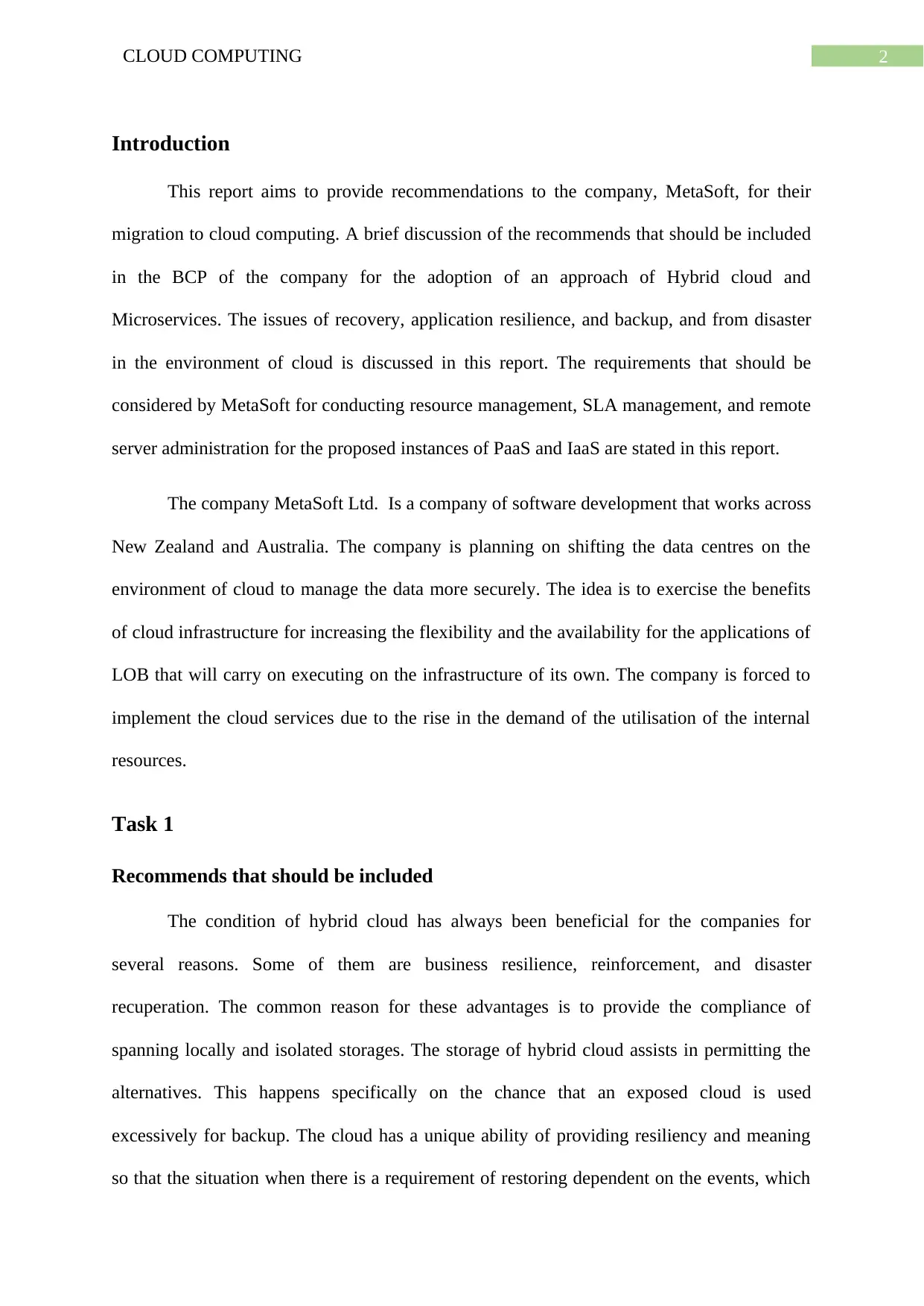
2CLOUD COMPUTING
Introduction
This report aims to provide recommendations to the company, MetaSoft, for their
migration to cloud computing. A brief discussion of the recommends that should be included
in the BCP of the company for the adoption of an approach of Hybrid cloud and
Microservices. The issues of recovery, application resilience, and backup, and from disaster
in the environment of cloud is discussed in this report. The requirements that should be
considered by MetaSoft for conducting resource management, SLA management, and remote
server administration for the proposed instances of PaaS and IaaS are stated in this report.
The company MetaSoft Ltd. Is a company of software development that works across
New Zealand and Australia. The company is planning on shifting the data centres on the
environment of cloud to manage the data more securely. The idea is to exercise the benefits
of cloud infrastructure for increasing the flexibility and the availability for the applications of
LOB that will carry on executing on the infrastructure of its own. The company is forced to
implement the cloud services due to the rise in the demand of the utilisation of the internal
resources.
Task 1
Recommends that should be included
The condition of hybrid cloud has always been beneficial for the companies for
several reasons. Some of them are business resilience, reinforcement, and disaster
recuperation. The common reason for these advantages is to provide the compliance of
spanning locally and isolated storages. The storage of hybrid cloud assists in permitting the
alternatives. This happens specifically on the chance that an exposed cloud is used
excessively for backup. The cloud has a unique ability of providing resiliency and meaning
so that the situation when there is a requirement of restoring dependent on the events, which
Introduction
This report aims to provide recommendations to the company, MetaSoft, for their
migration to cloud computing. A brief discussion of the recommends that should be included
in the BCP of the company for the adoption of an approach of Hybrid cloud and
Microservices. The issues of recovery, application resilience, and backup, and from disaster
in the environment of cloud is discussed in this report. The requirements that should be
considered by MetaSoft for conducting resource management, SLA management, and remote
server administration for the proposed instances of PaaS and IaaS are stated in this report.
The company MetaSoft Ltd. Is a company of software development that works across
New Zealand and Australia. The company is planning on shifting the data centres on the
environment of cloud to manage the data more securely. The idea is to exercise the benefits
of cloud infrastructure for increasing the flexibility and the availability for the applications of
LOB that will carry on executing on the infrastructure of its own. The company is forced to
implement the cloud services due to the rise in the demand of the utilisation of the internal
resources.
Task 1
Recommends that should be included
The condition of hybrid cloud has always been beneficial for the companies for
several reasons. Some of them are business resilience, reinforcement, and disaster
recuperation. The common reason for these advantages is to provide the compliance of
spanning locally and isolated storages. The storage of hybrid cloud assists in permitting the
alternatives. This happens specifically on the chance that an exposed cloud is used
excessively for backup. The cloud has a unique ability of providing resiliency and meaning
so that the situation when there is a requirement of restoring dependent on the events, which
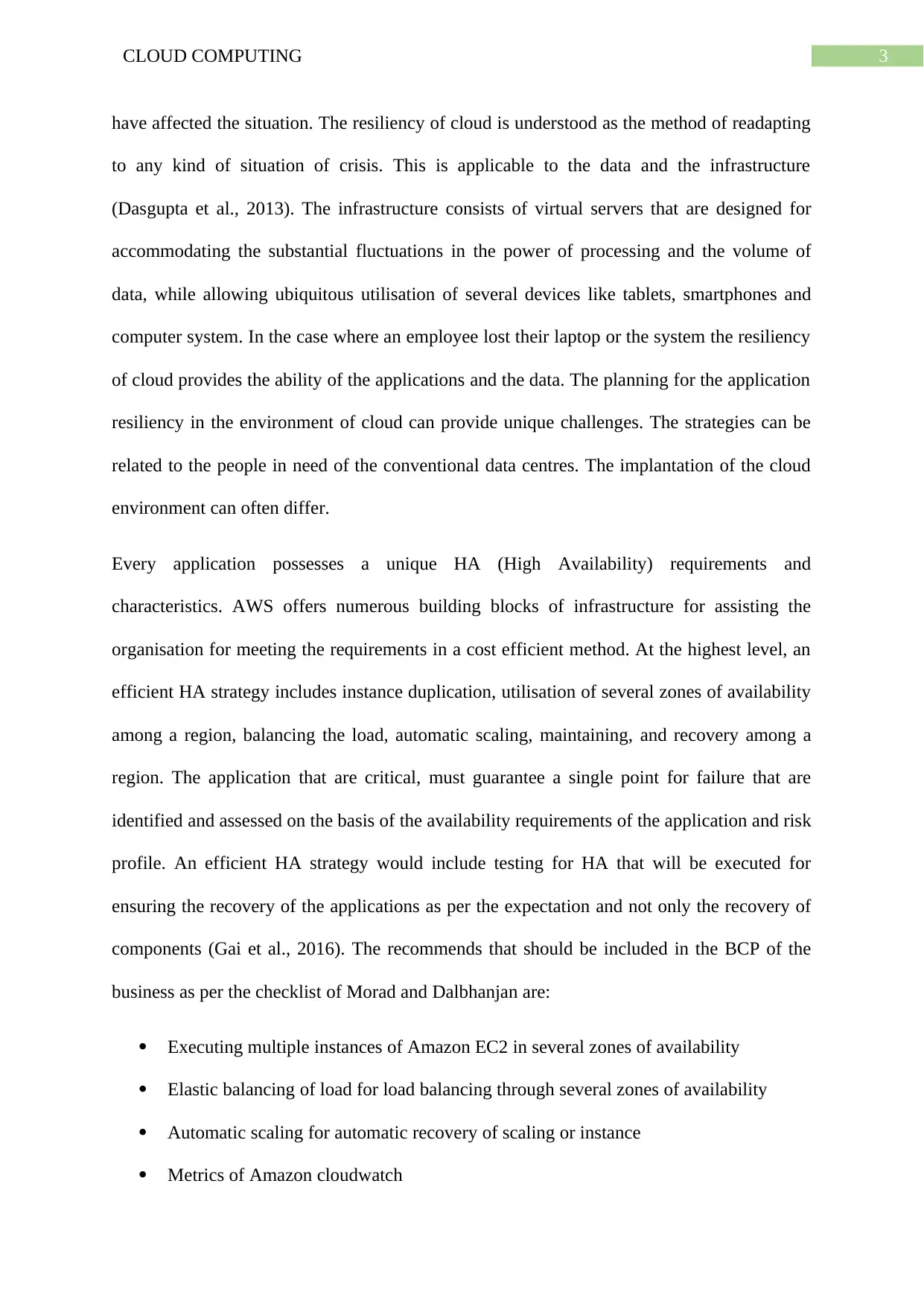
3CLOUD COMPUTING
have affected the situation. The resiliency of cloud is understood as the method of readapting
to any kind of situation of crisis. This is applicable to the data and the infrastructure
(Dasgupta et al., 2013). The infrastructure consists of virtual servers that are designed for
accommodating the substantial fluctuations in the power of processing and the volume of
data, while allowing ubiquitous utilisation of several devices like tablets, smartphones and
computer system. In the case where an employee lost their laptop or the system the resiliency
of cloud provides the ability of the applications and the data. The planning for the application
resiliency in the environment of cloud can provide unique challenges. The strategies can be
related to the people in need of the conventional data centres. The implantation of the cloud
environment can often differ.
Every application possesses a unique HA (High Availability) requirements and
characteristics. AWS offers numerous building blocks of infrastructure for assisting the
organisation for meeting the requirements in a cost efficient method. At the highest level, an
efficient HA strategy includes instance duplication, utilisation of several zones of availability
among a region, balancing the load, automatic scaling, maintaining, and recovery among a
region. The application that are critical, must guarantee a single point for failure that are
identified and assessed on the basis of the availability requirements of the application and risk
profile. An efficient HA strategy would include testing for HA that will be executed for
ensuring the recovery of the applications as per the expectation and not only the recovery of
components (Gai et al., 2016). The recommends that should be included in the BCP of the
business as per the checklist of Morad and Dalbhanjan are:
Executing multiple instances of Amazon EC2 in several zones of availability
Elastic balancing of load for load balancing through several zones of availability
Automatic scaling for automatic recovery of scaling or instance
Metrics of Amazon cloudwatch
have affected the situation. The resiliency of cloud is understood as the method of readapting
to any kind of situation of crisis. This is applicable to the data and the infrastructure
(Dasgupta et al., 2013). The infrastructure consists of virtual servers that are designed for
accommodating the substantial fluctuations in the power of processing and the volume of
data, while allowing ubiquitous utilisation of several devices like tablets, smartphones and
computer system. In the case where an employee lost their laptop or the system the resiliency
of cloud provides the ability of the applications and the data. The planning for the application
resiliency in the environment of cloud can provide unique challenges. The strategies can be
related to the people in need of the conventional data centres. The implantation of the cloud
environment can often differ.
Every application possesses a unique HA (High Availability) requirements and
characteristics. AWS offers numerous building blocks of infrastructure for assisting the
organisation for meeting the requirements in a cost efficient method. At the highest level, an
efficient HA strategy includes instance duplication, utilisation of several zones of availability
among a region, balancing the load, automatic scaling, maintaining, and recovery among a
region. The application that are critical, must guarantee a single point for failure that are
identified and assessed on the basis of the availability requirements of the application and risk
profile. An efficient HA strategy would include testing for HA that will be executed for
ensuring the recovery of the applications as per the expectation and not only the recovery of
components (Gai et al., 2016). The recommends that should be included in the BCP of the
business as per the checklist of Morad and Dalbhanjan are:
Executing multiple instances of Amazon EC2 in several zones of availability
Elastic balancing of load for load balancing through several zones of availability
Automatic scaling for automatic recovery of scaling or instance
Metrics of Amazon cloudwatch
Secure Best Marks with AI Grader
Need help grading? Try our AI Grader for instant feedback on your assignments.
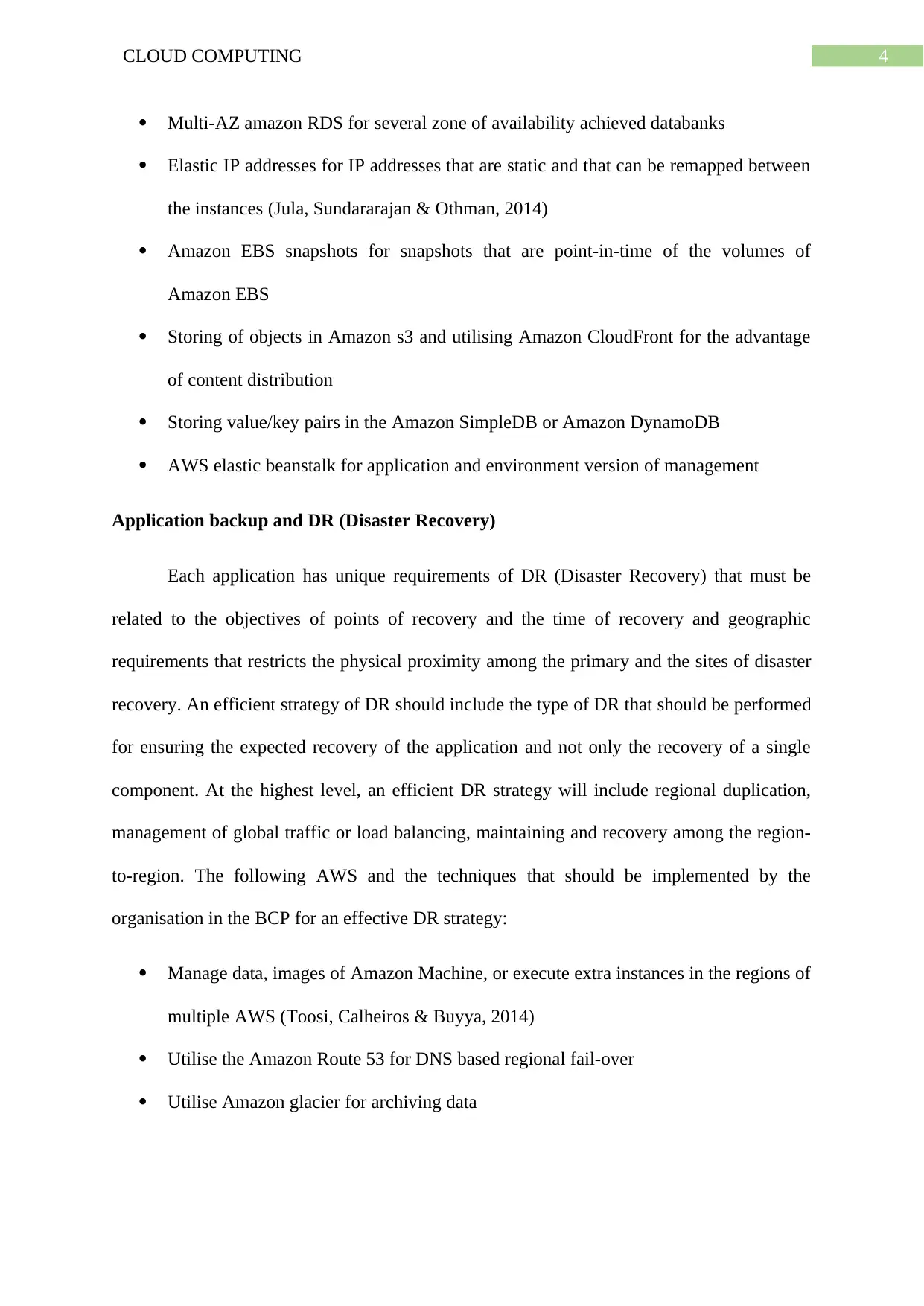
4CLOUD COMPUTING
Multi-AZ amazon RDS for several zone of availability achieved databanks
Elastic IP addresses for IP addresses that are static and that can be remapped between
the instances (Jula, Sundararajan & Othman, 2014)
Amazon EBS snapshots for snapshots that are point-in-time of the volumes of
Amazon EBS
Storing of objects in Amazon s3 and utilising Amazon CloudFront for the advantage
of content distribution
Storing value/key pairs in the Amazon SimpleDB or Amazon DynamoDB
AWS elastic beanstalk for application and environment version of management
Application backup and DR (Disaster Recovery)
Each application has unique requirements of DR (Disaster Recovery) that must be
related to the objectives of points of recovery and the time of recovery and geographic
requirements that restricts the physical proximity among the primary and the sites of disaster
recovery. An efficient strategy of DR should include the type of DR that should be performed
for ensuring the expected recovery of the application and not only the recovery of a single
component. At the highest level, an efficient DR strategy will include regional duplication,
management of global traffic or load balancing, maintaining and recovery among the region-
to-region. The following AWS and the techniques that should be implemented by the
organisation in the BCP for an effective DR strategy:
Manage data, images of Amazon Machine, or execute extra instances in the regions of
multiple AWS (Toosi, Calheiros & Buyya, 2014)
Utilise the Amazon Route 53 for DNS based regional fail-over
Utilise Amazon glacier for archiving data
Multi-AZ amazon RDS for several zone of availability achieved databanks
Elastic IP addresses for IP addresses that are static and that can be remapped between
the instances (Jula, Sundararajan & Othman, 2014)
Amazon EBS snapshots for snapshots that are point-in-time of the volumes of
Amazon EBS
Storing of objects in Amazon s3 and utilising Amazon CloudFront for the advantage
of content distribution
Storing value/key pairs in the Amazon SimpleDB or Amazon DynamoDB
AWS elastic beanstalk for application and environment version of management
Application backup and DR (Disaster Recovery)
Each application has unique requirements of DR (Disaster Recovery) that must be
related to the objectives of points of recovery and the time of recovery and geographic
requirements that restricts the physical proximity among the primary and the sites of disaster
recovery. An efficient strategy of DR should include the type of DR that should be performed
for ensuring the expected recovery of the application and not only the recovery of a single
component. At the highest level, an efficient DR strategy will include regional duplication,
management of global traffic or load balancing, maintaining and recovery among the region-
to-region. The following AWS and the techniques that should be implemented by the
organisation in the BCP for an effective DR strategy:
Manage data, images of Amazon Machine, or execute extra instances in the regions of
multiple AWS (Toosi, Calheiros & Buyya, 2014)
Utilise the Amazon Route 53 for DNS based regional fail-over
Utilise Amazon glacier for archiving data

5CLOUD COMPUTING
Influence technologies of asynchronous replication of data such as shipping of log
database
Reserve the DR capacity in another region with the help of Amazon EC2 reserved
instances
Utilisation of EBS snapshot copy and AMI(Amazon Machine Image) across the
regions
Undertaking periodic Amazon EBS snapshots or tools of third party to regaining
quickly from loss of data (Li et al., 2015)
The recommends that should be included in the BCP for backup are:
Designing Fault tolerant application in the cloud
RDBMS in the cloud: Microsoft SQL server 2008 R2
Providing control to the Amazon S3 versioning for providing extra protection to the
stored data
Task 2
Requirements of remote server administration
Remote administration is referred as the method or procedural process of leading,
controlling of devices of computing from an isolated location. This method includes the
utilisation of any kind of software, which are included for developing for suiting the process.
These software that permits control from an isolated location are becoming increasingly
popular in the modern times (Shiraz et al., 2013).
The several requirements for remote administration are:
Internet connectivity: for remotely controlling any kind of computing device, a
connection of internet is required, which can be either LAN (Local Area Network) or TCP/IP.
Influence technologies of asynchronous replication of data such as shipping of log
database
Reserve the DR capacity in another region with the help of Amazon EC2 reserved
instances
Utilisation of EBS snapshot copy and AMI(Amazon Machine Image) across the
regions
Undertaking periodic Amazon EBS snapshots or tools of third party to regaining
quickly from loss of data (Li et al., 2015)
The recommends that should be included in the BCP for backup are:
Designing Fault tolerant application in the cloud
RDBMS in the cloud: Microsoft SQL server 2008 R2
Providing control to the Amazon S3 versioning for providing extra protection to the
stored data
Task 2
Requirements of remote server administration
Remote administration is referred as the method or procedural process of leading,
controlling of devices of computing from an isolated location. This method includes the
utilisation of any kind of software, which are included for developing for suiting the process.
These software that permits control from an isolated location are becoming increasingly
popular in the modern times (Shiraz et al., 2013).
The several requirements for remote administration are:
Internet connectivity: for remotely controlling any kind of computing device, a
connection of internet is required, which can be either LAN (Local Area Network) or TCP/IP.
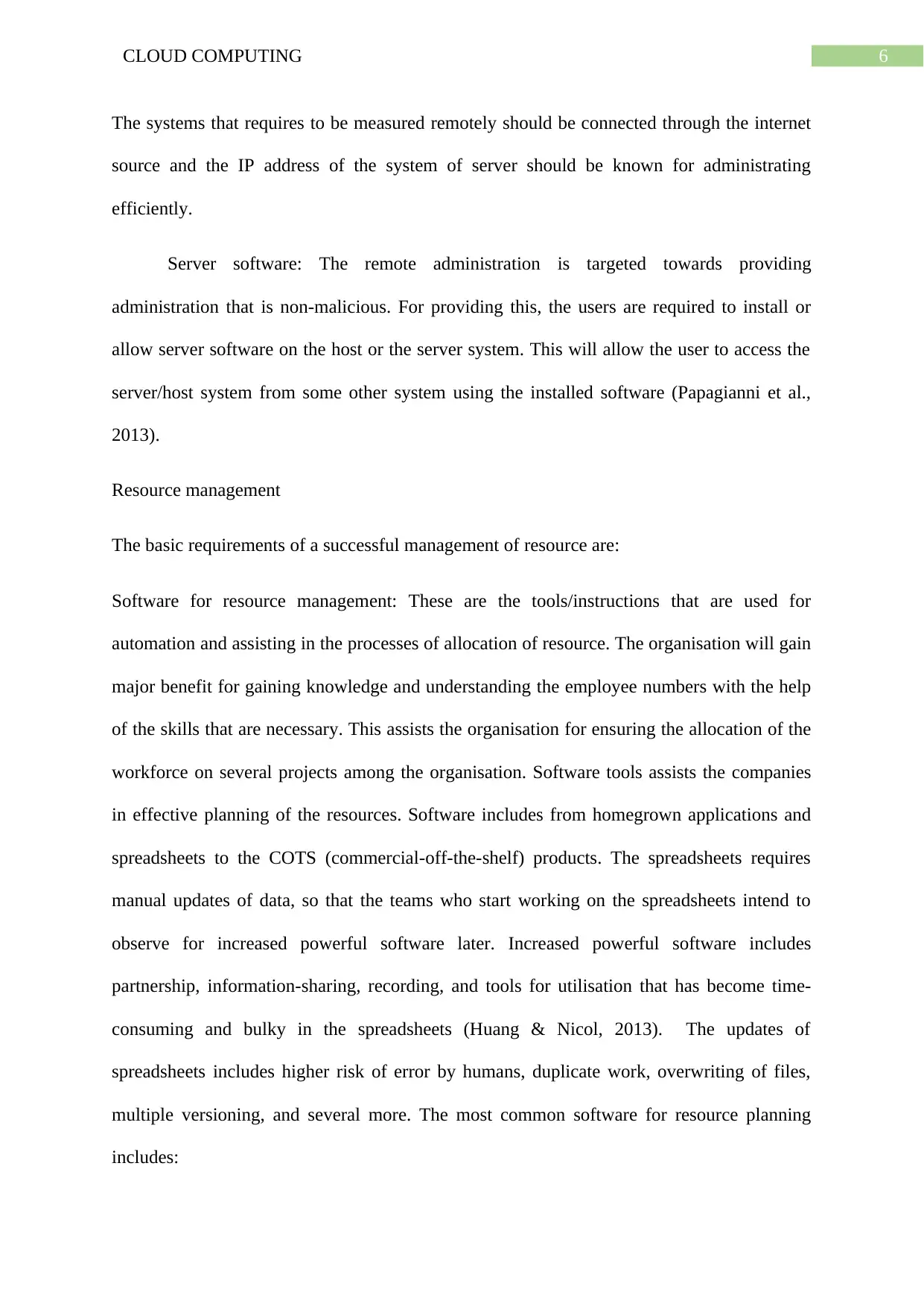
6CLOUD COMPUTING
The systems that requires to be measured remotely should be connected through the internet
source and the IP address of the system of server should be known for administrating
efficiently.
Server software: The remote administration is targeted towards providing
administration that is non-malicious. For providing this, the users are required to install or
allow server software on the host or the server system. This will allow the user to access the
server/host system from some other system using the installed software (Papagianni et al.,
2013).
Resource management
The basic requirements of a successful management of resource are:
Software for resource management: These are the tools/instructions that are used for
automation and assisting in the processes of allocation of resource. The organisation will gain
major benefit for gaining knowledge and understanding the employee numbers with the help
of the skills that are necessary. This assists the organisation for ensuring the allocation of the
workforce on several projects among the organisation. Software tools assists the companies
in effective planning of the resources. Software includes from homegrown applications and
spreadsheets to the COTS (commercial-off-the-shelf) products. The spreadsheets requires
manual updates of data, so that the teams who start working on the spreadsheets intend to
observe for increased powerful software later. Increased powerful software includes
partnership, information-sharing, recording, and tools for utilisation that has become time-
consuming and bulky in the spreadsheets (Huang & Nicol, 2013). The updates of
spreadsheets includes higher risk of error by humans, duplicate work, overwriting of files,
multiple versioning, and several more. The most common software for resource planning
includes:
The systems that requires to be measured remotely should be connected through the internet
source and the IP address of the system of server should be known for administrating
efficiently.
Server software: The remote administration is targeted towards providing
administration that is non-malicious. For providing this, the users are required to install or
allow server software on the host or the server system. This will allow the user to access the
server/host system from some other system using the installed software (Papagianni et al.,
2013).
Resource management
The basic requirements of a successful management of resource are:
Software for resource management: These are the tools/instructions that are used for
automation and assisting in the processes of allocation of resource. The organisation will gain
major benefit for gaining knowledge and understanding the employee numbers with the help
of the skills that are necessary. This assists the organisation for ensuring the allocation of the
workforce on several projects among the organisation. Software tools assists the companies
in effective planning of the resources. Software includes from homegrown applications and
spreadsheets to the COTS (commercial-off-the-shelf) products. The spreadsheets requires
manual updates of data, so that the teams who start working on the spreadsheets intend to
observe for increased powerful software later. Increased powerful software includes
partnership, information-sharing, recording, and tools for utilisation that has become time-
consuming and bulky in the spreadsheets (Huang & Nicol, 2013). The updates of
spreadsheets includes higher risk of error by humans, duplicate work, overwriting of files,
multiple versioning, and several more. The most common software for resource planning
includes:
Paraphrase This Document
Need a fresh take? Get an instant paraphrase of this document with our AI Paraphraser

7CLOUD COMPUTING
Resource planning
Utilisation reporting
Resources scheduling
Forecasting of resource availability
Resource discovery
Resource auditing
Resource levelling: this is the technique where the starting and the finishing data are adjusted
on the basis of the constraints of the resource with the intent of balancing the demand of the
resources with the accessible supply. The process of resolving the conflict where one kind of
resource is required in many tasks at the same time is referred as project planning resource
levelling. It is beneficial for balancing the workload of the primary resources during the
project and specially at the expense of one of a conventional threefold restraints. When the
company is utilising specially designed software of project, the levelling commonly denotes
to resolving the conflicts or extra allocation in the project plan by permitting the software for
calculating the delays and the automatic upgrading of the tasks. The software of project
management levelling needs the delaying of the tasks till the resources are accessible. In
some more complicated environments, resources can be allocated in multiple, concurrent
projects and thus requiring the method of resource levelling that needs to be executed at the
level of the company. Levelling can lead to increased finish date of the project if the affected
tasks are in a critical path.
SLA management
SLA or service level agreement means a contract that is subsists among the service provider
and end user or clients that denoted the levels and the standards of the service that the client
must hope from the service provider. These specifically defines the assets that the customer
Resource planning
Utilisation reporting
Resources scheduling
Forecasting of resource availability
Resource discovery
Resource auditing
Resource levelling: this is the technique where the starting and the finishing data are adjusted
on the basis of the constraints of the resource with the intent of balancing the demand of the
resources with the accessible supply. The process of resolving the conflict where one kind of
resource is required in many tasks at the same time is referred as project planning resource
levelling. It is beneficial for balancing the workload of the primary resources during the
project and specially at the expense of one of a conventional threefold restraints. When the
company is utilising specially designed software of project, the levelling commonly denotes
to resolving the conflicts or extra allocation in the project plan by permitting the software for
calculating the delays and the automatic upgrading of the tasks. The software of project
management levelling needs the delaying of the tasks till the resources are accessible. In
some more complicated environments, resources can be allocated in multiple, concurrent
projects and thus requiring the method of resource levelling that needs to be executed at the
level of the company. Levelling can lead to increased finish date of the project if the affected
tasks are in a critical path.
SLA management
SLA or service level agreement means a contract that is subsists among the service provider
and end user or clients that denoted the levels and the standards of the service that the client
must hope from the service provider. These specifically defines the assets that the customer
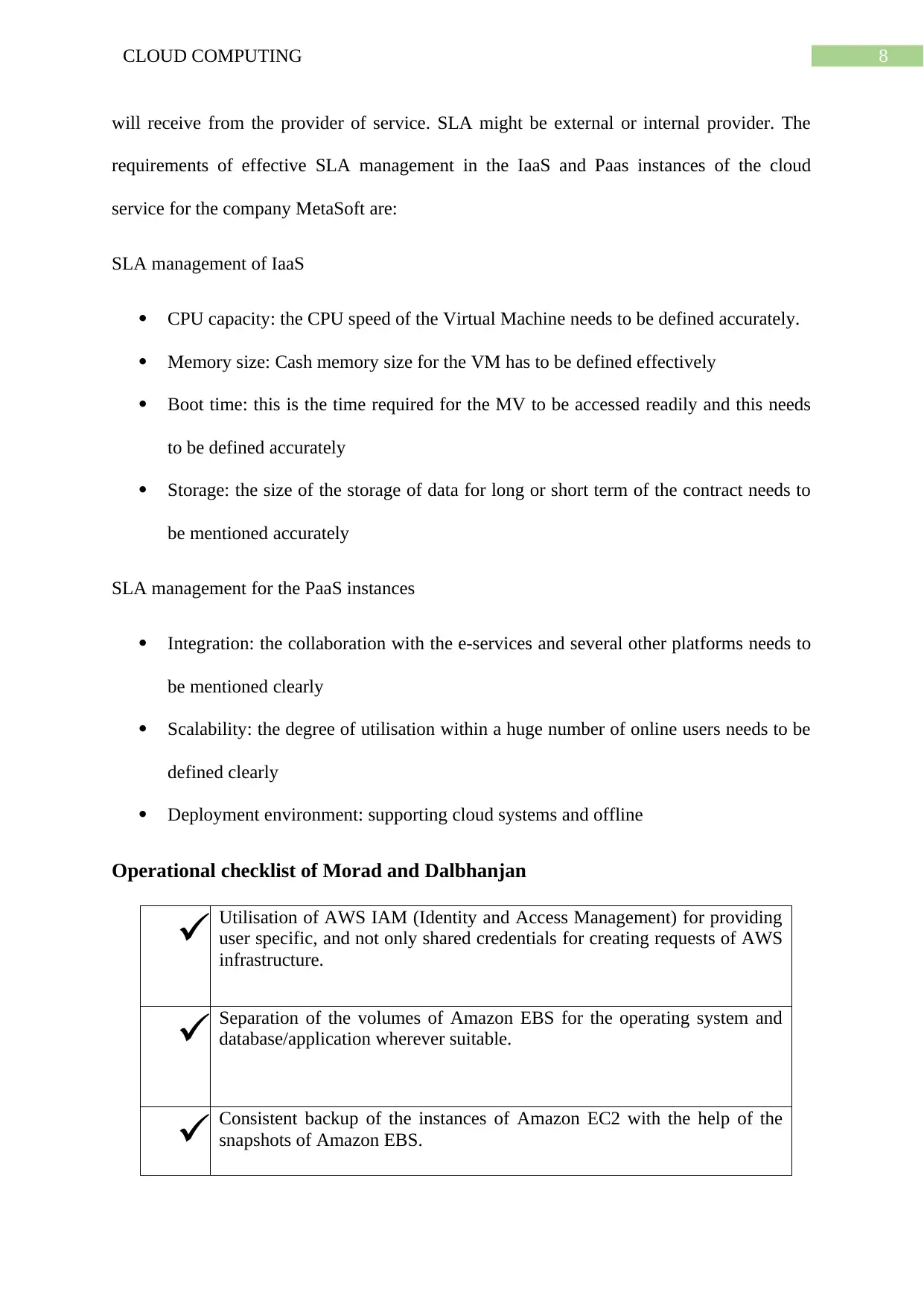
8CLOUD COMPUTING
will receive from the provider of service. SLA might be external or internal provider. The
requirements of effective SLA management in the IaaS and Paas instances of the cloud
service for the company MetaSoft are:
SLA management of IaaS
CPU capacity: the CPU speed of the Virtual Machine needs to be defined accurately.
Memory size: Cash memory size for the VM has to be defined effectively
Boot time: this is the time required for the MV to be accessed readily and this needs
to be defined accurately
Storage: the size of the storage of data for long or short term of the contract needs to
be mentioned accurately
SLA management for the PaaS instances
Integration: the collaboration with the e-services and several other platforms needs to
be mentioned clearly
Scalability: the degree of utilisation within a huge number of online users needs to be
defined clearly
Deployment environment: supporting cloud systems and offline
Operational checklist of Morad and Dalbhanjan
Utilisation of AWS IAM (Identity and Access Management) for providing
user specific, and not only shared credentials for creating requests of AWS
infrastructure.
Separation of the volumes of Amazon EBS for the operating system and
database/application wherever suitable.
Consistent backup of the instances of Amazon EC2 with the help of the
snapshots of Amazon EBS.
will receive from the provider of service. SLA might be external or internal provider. The
requirements of effective SLA management in the IaaS and Paas instances of the cloud
service for the company MetaSoft are:
SLA management of IaaS
CPU capacity: the CPU speed of the Virtual Machine needs to be defined accurately.
Memory size: Cash memory size for the VM has to be defined effectively
Boot time: this is the time required for the MV to be accessed readily and this needs
to be defined accurately
Storage: the size of the storage of data for long or short term of the contract needs to
be mentioned accurately
SLA management for the PaaS instances
Integration: the collaboration with the e-services and several other platforms needs to
be mentioned clearly
Scalability: the degree of utilisation within a huge number of online users needs to be
defined clearly
Deployment environment: supporting cloud systems and offline
Operational checklist of Morad and Dalbhanjan
Utilisation of AWS IAM (Identity and Access Management) for providing
user specific, and not only shared credentials for creating requests of AWS
infrastructure.
Separation of the volumes of Amazon EBS for the operating system and
database/application wherever suitable.
Consistent backup of the instances of Amazon EC2 with the help of the
snapshots of Amazon EBS.
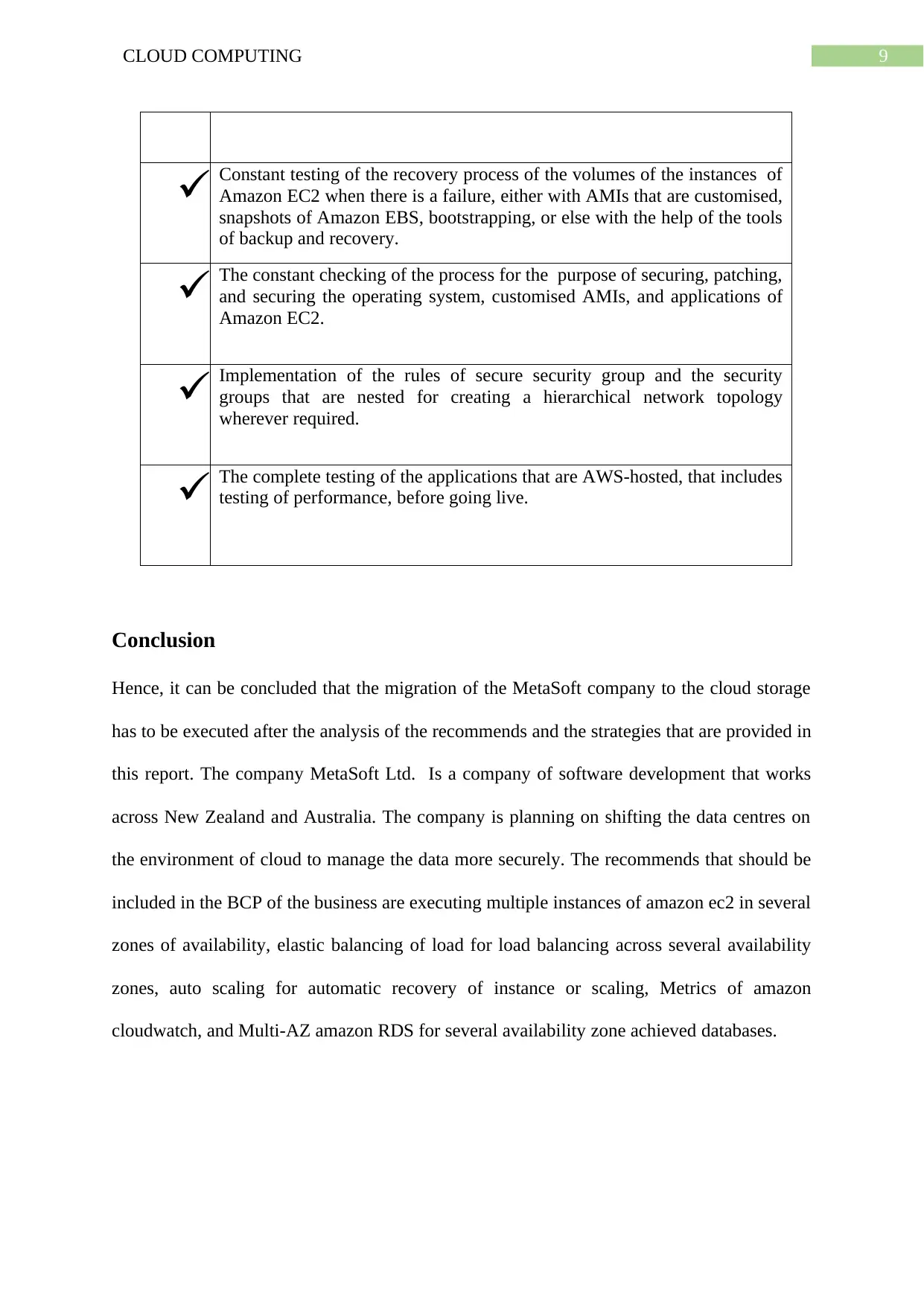
9CLOUD COMPUTING
Constant testing of the recovery process of the volumes of the instances of
Amazon EC2 when there is a failure, either with AMIs that are customised,
snapshots of Amazon EBS, bootstrapping, or else with the help of the tools
of backup and recovery.
The constant checking of the process for the purpose of securing, patching,
and securing the operating system, customised AMIs, and applications of
Amazon EC2.
Implementation of the rules of secure security group and the security
groups that are nested for creating a hierarchical network topology
wherever required.
The complete testing of the applications that are AWS-hosted, that includes
testing of performance, before going live.
Conclusion
Hence, it can be concluded that the migration of the MetaSoft company to the cloud storage
has to be executed after the analysis of the recommends and the strategies that are provided in
this report. The company MetaSoft Ltd. Is a company of software development that works
across New Zealand and Australia. The company is planning on shifting the data centres on
the environment of cloud to manage the data more securely. The recommends that should be
included in the BCP of the business are executing multiple instances of amazon ec2 in several
zones of availability, elastic balancing of load for load balancing across several availability
zones, auto scaling for automatic recovery of instance or scaling, Metrics of amazon
cloudwatch, and Multi-AZ amazon RDS for several availability zone achieved databases.
Constant testing of the recovery process of the volumes of the instances of
Amazon EC2 when there is a failure, either with AMIs that are customised,
snapshots of Amazon EBS, bootstrapping, or else with the help of the tools
of backup and recovery.
The constant checking of the process for the purpose of securing, patching,
and securing the operating system, customised AMIs, and applications of
Amazon EC2.
Implementation of the rules of secure security group and the security
groups that are nested for creating a hierarchical network topology
wherever required.
The complete testing of the applications that are AWS-hosted, that includes
testing of performance, before going live.
Conclusion
Hence, it can be concluded that the migration of the MetaSoft company to the cloud storage
has to be executed after the analysis of the recommends and the strategies that are provided in
this report. The company MetaSoft Ltd. Is a company of software development that works
across New Zealand and Australia. The company is planning on shifting the data centres on
the environment of cloud to manage the data more securely. The recommends that should be
included in the BCP of the business are executing multiple instances of amazon ec2 in several
zones of availability, elastic balancing of load for load balancing across several availability
zones, auto scaling for automatic recovery of instance or scaling, Metrics of amazon
cloudwatch, and Multi-AZ amazon RDS for several availability zone achieved databases.
Secure Best Marks with AI Grader
Need help grading? Try our AI Grader for instant feedback on your assignments.
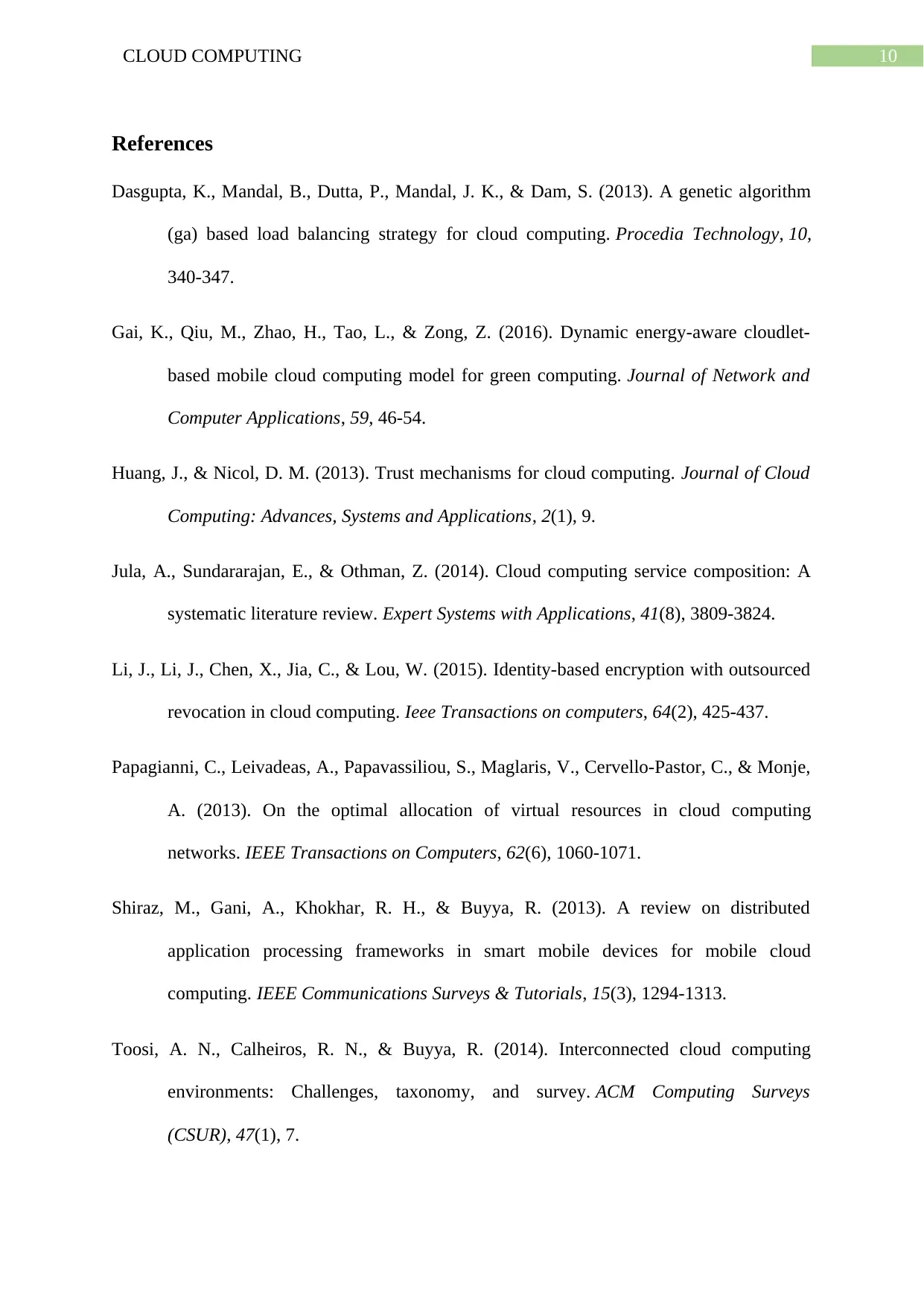
10CLOUD COMPUTING
References
Dasgupta, K., Mandal, B., Dutta, P., Mandal, J. K., & Dam, S. (2013). A genetic algorithm
(ga) based load balancing strategy for cloud computing. Procedia Technology, 10,
340-347.
Gai, K., Qiu, M., Zhao, H., Tao, L., & Zong, Z. (2016). Dynamic energy-aware cloudlet-
based mobile cloud computing model for green computing. Journal of Network and
Computer Applications, 59, 46-54.
Huang, J., & Nicol, D. M. (2013). Trust mechanisms for cloud computing. Journal of Cloud
Computing: Advances, Systems and Applications, 2(1), 9.
Jula, A., Sundararajan, E., & Othman, Z. (2014). Cloud computing service composition: A
systematic literature review. Expert Systems with Applications, 41(8), 3809-3824.
Li, J., Li, J., Chen, X., Jia, C., & Lou, W. (2015). Identity-based encryption with outsourced
revocation in cloud computing. Ieee Transactions on computers, 64(2), 425-437.
Papagianni, C., Leivadeas, A., Papavassiliou, S., Maglaris, V., Cervello-Pastor, C., & Monje,
A. (2013). On the optimal allocation of virtual resources in cloud computing
networks. IEEE Transactions on Computers, 62(6), 1060-1071.
Shiraz, M., Gani, A., Khokhar, R. H., & Buyya, R. (2013). A review on distributed
application processing frameworks in smart mobile devices for mobile cloud
computing. IEEE Communications Surveys & Tutorials, 15(3), 1294-1313.
Toosi, A. N., Calheiros, R. N., & Buyya, R. (2014). Interconnected cloud computing
environments: Challenges, taxonomy, and survey. ACM Computing Surveys
(CSUR), 47(1), 7.
References
Dasgupta, K., Mandal, B., Dutta, P., Mandal, J. K., & Dam, S. (2013). A genetic algorithm
(ga) based load balancing strategy for cloud computing. Procedia Technology, 10,
340-347.
Gai, K., Qiu, M., Zhao, H., Tao, L., & Zong, Z. (2016). Dynamic energy-aware cloudlet-
based mobile cloud computing model for green computing. Journal of Network and
Computer Applications, 59, 46-54.
Huang, J., & Nicol, D. M. (2013). Trust mechanisms for cloud computing. Journal of Cloud
Computing: Advances, Systems and Applications, 2(1), 9.
Jula, A., Sundararajan, E., & Othman, Z. (2014). Cloud computing service composition: A
systematic literature review. Expert Systems with Applications, 41(8), 3809-3824.
Li, J., Li, J., Chen, X., Jia, C., & Lou, W. (2015). Identity-based encryption with outsourced
revocation in cloud computing. Ieee Transactions on computers, 64(2), 425-437.
Papagianni, C., Leivadeas, A., Papavassiliou, S., Maglaris, V., Cervello-Pastor, C., & Monje,
A. (2013). On the optimal allocation of virtual resources in cloud computing
networks. IEEE Transactions on Computers, 62(6), 1060-1071.
Shiraz, M., Gani, A., Khokhar, R. H., & Buyya, R. (2013). A review on distributed
application processing frameworks in smart mobile devices for mobile cloud
computing. IEEE Communications Surveys & Tutorials, 15(3), 1294-1313.
Toosi, A. N., Calheiros, R. N., & Buyya, R. (2014). Interconnected cloud computing
environments: Challenges, taxonomy, and survey. ACM Computing Surveys
(CSUR), 47(1), 7.

11CLOUD COMPUTING
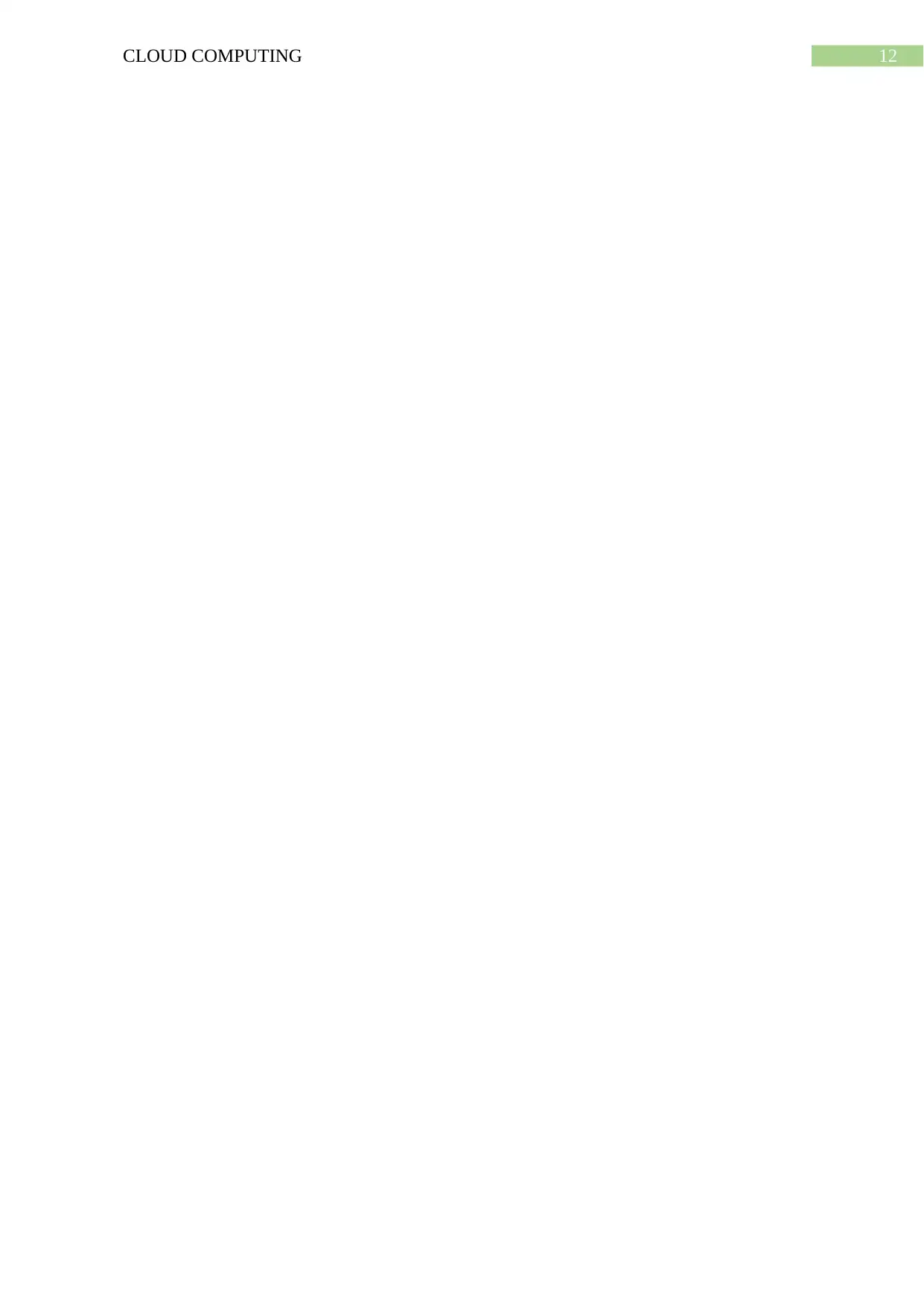
12CLOUD COMPUTING
Paraphrase This Document
Need a fresh take? Get an instant paraphrase of this document with our AI Paraphraser
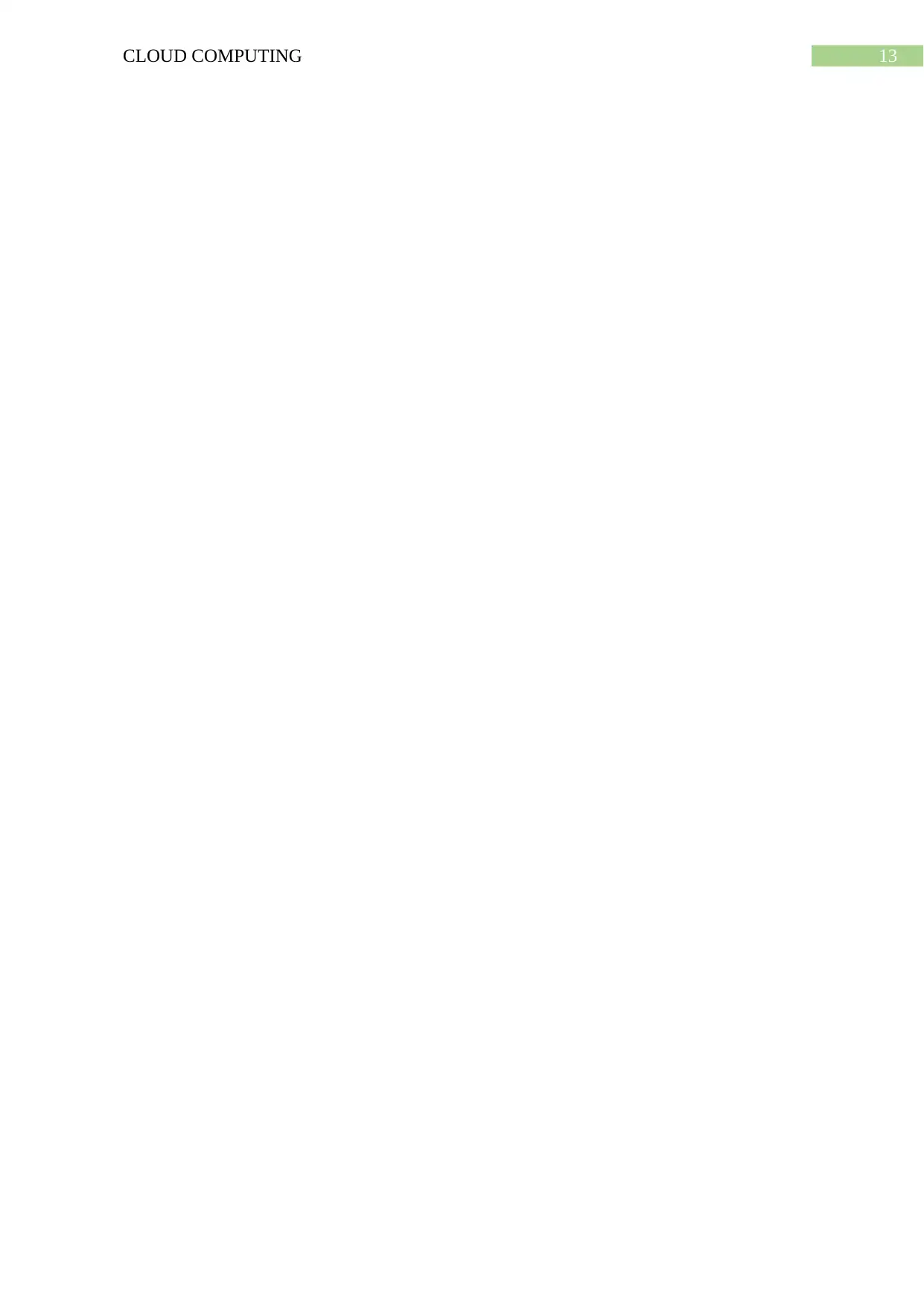
13CLOUD COMPUTING
1 out of 14
Related Documents
Your All-in-One AI-Powered Toolkit for Academic Success.
+13062052269
info@desklib.com
Available 24*7 on WhatsApp / Email
![[object Object]](/_next/static/media/star-bottom.7253800d.svg)
Unlock your academic potential
© 2024 | Zucol Services PVT LTD | All rights reserved.





